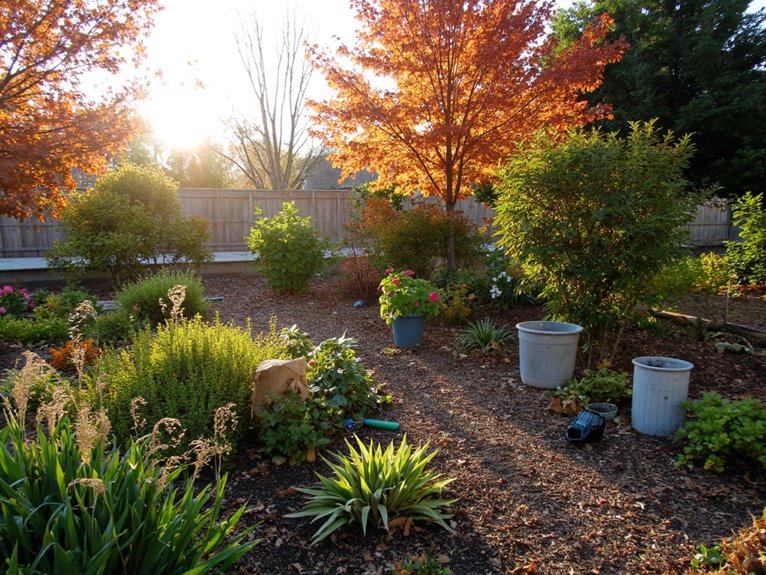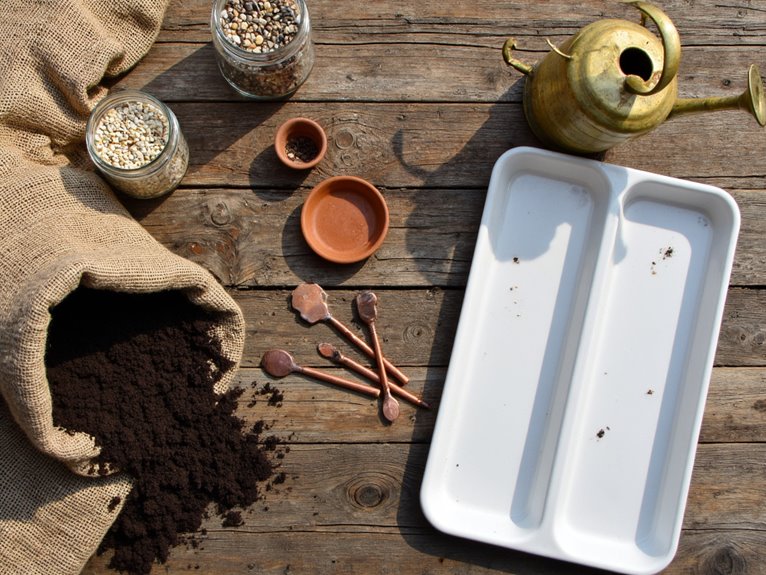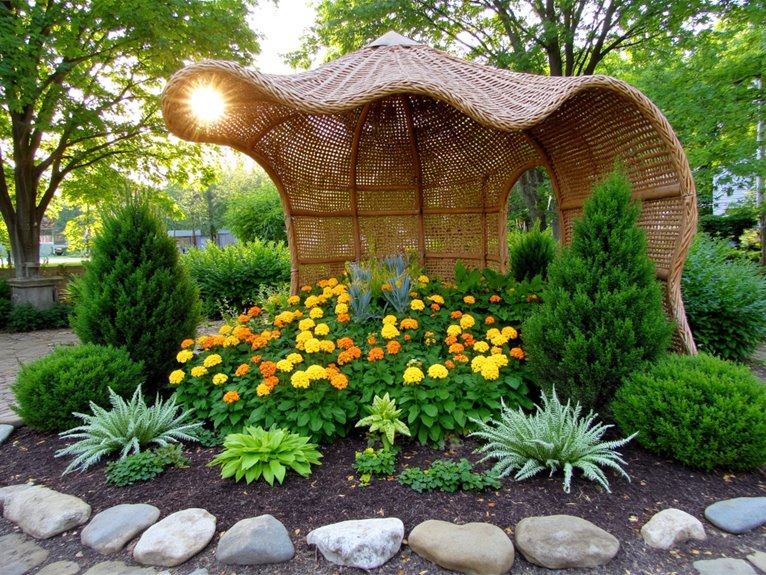LED Grow Light Setup: Installing Artificial Lighting Systems for Indoor Plant Gardens
Setting up your LED grow light system starts with positioning – keep bulbs at least 24 inches away from plants to avoid heat damage and adjust heights as they grow. Choose a blue-dominant spectrum for seedlings and switch to red light for flowering stages, many systems let you control these independently. Make sure to use the right electrical setup, always calculating wattage needs and using UL-listed components for safety. With proper installation, your plants will thrive under precise, energy-efficient lighting that supports each growth phase.
Notable Insights
- Position lights 24 inches away from plants to avoid heat damage and ensure even coverage.
- Use blue light for seedlings and red light for flowering stages with adjustable spectrum controls.
- Install on a dimmable system to match plant growth phases and optimize energy use.
- Choose LED systems with high efficiency and long lifespan to reduce costs over time.
- Ensure proper wiring, fuses, and safety certifications to prevent electrical hazards in grow areas.
Positioning and Distance Guidelines
Experiment with small adjustments first, then fine-tune based on plant response. The goal is to maximize photosynthesis without overheating. With the right distance adjustments, your grow setup will thrive! Proper spacing is crucial preventing heat damage, especially for incandescent bulbs that require at least 24 inches of distance.
Selecting the Optimal Light Spectrum
While choosing your grow light spectrum might feel a bit overwhelming at first, the right balance can make all the difference in your plants’ health and harvest. Blue light builds compact stems and leaves, red boosts flowering and yield, and green supports photosynthesis. The perfect light spectrum depends on your crop type and growth stage—seedlings need more blue, while flowers benefit from red dominance. As plants develop, you’ll likely need spectral adjustment to maintain ideal plant morphology. Higher light intensity with the right spectrum composition can dramatically improve biomass and flavor profiles. Many models offer dual switches for independent control of red and blue light spectrums, with customizable lighting schedules featuring multiple wavelengths from 3000K to 760nm for optimizing plant development. Don’t worry if you’re not sure where to start; many modern systems offer preset modes for different stages. Experiment carefully, but remember: a well-chosen spectrum can transform your indoor garden from ordinary to outstanding.
Installation Techniques for Even Coverage
After setting the right spectrum for your plants, it’s time to think about how you place and manage your LED lights to guarantee every leaf gets its fair share of illumination. Proper light spacing prevents shadowing while avoiding light stress by positioning medium-power units 18-30 inches above and high-power ones 24-36 inches away. Use coverage mapping with PAR meters to measure intensity across your canopy, identifying underlit zones. Adjust fixture heights regularly as plants grow using adjustable hang systems. Consider staggered layouts or light movers for dense gardens, ensuring all leaves receive adequate photons. Gooseneck designs with 360-degree rotation enable precise light placement for optimal coverage across your growing area. Remember, even distribution isn’t just about brightness – it’s about creating a balanced environment where every plant thrives equally. With higher-quality full-spectrum LEDs, SPECTRUM QUALITY allows closer positioning without risking light burn.
Electrical Requirements and Safety Precautions
Before you power up your LED grow system it’s essential to understand the electrical foundation that supports it. Higher voltages like 240V over 120V cut amperage needs, letting you fit more lights on a single circuit without upgrading wiring or breakers. But don’t forget about circuit calculations – always add up the actual wattage of all connected lights to guarantee your breaker can handle the load. Selecting the right driver is equally important; these convert AC power to DC needed by LEDs and help regulate their operation. Make certain drivers match the LED array specifications exactly. For safety, use only UL-listed components, keep connections tight and insulated, and consider GFCIs in humid grow rooms. Proper electrical planning prevents overheating, fire risks, and guarantees your system runs efficiently.
Setting the Perfect Lighting Schedule
How exactly does light timing shape your plants’ journey from seed to harvest? The perfect lighting schedule depends on the plant’s growth phase. Vegetative stages need 18-24 hours of light daily to boost growth, while flowering usually calls for a 12/12 cycle to trigger blooms. Seedlings benefit from 16-18 hours to avoid legginess. Consistent photoperiod adjustments prevent plant stress and support steady development. Too much or too little light can cause issues like leaf curling or delayed flowering. By matching your light schedule to the plant’s needs, you create ideal conditions for growth without overwhelming it. Modern grow lights with programmable timers can automate these lighting schedules with preset options of 3, 4, 8, 9, or 12 hours, eliminating the need for daily manual adjustments.
Maintenance Tips for Long-Lasting LEDs
Once you’ve set that perfect lighting schedule, keeping your LEDs in top shape is just as important. Establish consistent cleaning intervals—twice monthly at minimum—to prevent dust buildup that can cut light intensity by up to 90%. Use a soft cloth with isopropyl alcohol mix for gentle cleaning, and try the vinegar solution for mineral deposits. Don’t forget component inspection: check LED panels for flickering or discoloration, examine wiring for fraying, and verify heatsinks remain clean to prevent overheating. Handle lights carefully to avoid damaging delicate components. With proper care, your system can last 5-10 years, supporting healthy plant growth effortlessly.
Cost Analysis of LED Grow Lighting Systems
As you plan your grow operation, evaluating the true cost of LED lighting goes beyond just the upfront price—it includes energy consumption, maintenance needs, and how efficiently these lights support plant growth. LEDs deliver outstanding energy efficiency, using less power than traditional HPS systems while providing tailored light spectra for ideal plant stages. This translates to real cost savings over time, with annual electricity bills often running in the hundreds or thousands less than conventional setups. While upfront costs may be higher, their long lifespan and low maintenance needs make them a smart investment. Plus, many regions offer rebates that further cut initial expenses. By prioritizing energy-efficient systems, you’re not just saving money—you’re also supporting sustainable practices that benefit your garden’s health and the environment.
Comparing LED to Traditional Grow Lights
While traditional grow lights have long been a staple in cultivation setups, modern LED systems offer distinct advantages that make them increasingly valuable for indoor gardens. LEDs provide targeted red/blue spectra for photosynthesis, higher intensity (PPFD >1000 µMol/m²/s), reduced heat output, and longer lifespans. Their light efficiency supports robust growth while minimizing energy costs.
| Feature | LED Grow Lights | Traditional Grow Lights |
|---|---|---|
| Spectrum Quality | Red/blue targeting, full-spectrum options | Broad-spectrum for humans, less optimized for plants |
| Heat Output | 40-50% lower due to cooling tech | Higher heat requiring distance |
| Lifespan | 50,000+ hours | 15,000-50,000 hours |
LED advantages like precise Light efficiency make them ideal for growers seeking consistent, high-yield environments. Consider how these benefits support your specific cultivation goals.
Smart Controls for Automated Lighting Management
Whether you’re just starting out or running a commercial grow operation, smart controls can transform how you manage your indoor garden’s lighting. These systems enable automated dimming, letting you adjust brightness based on plant needs or time of day, while also supporting environmental integration to sync with temperature and humidity levels. You can set timers for sunrise and sunset effects or use apps to control lights remotely. Some controllers even respond to environmental sensors, changing light intensity as plants grow. This not only saves energy but improves yields by providing perfect conditions at each growth stage. With smart controls, gardening becomes more efficient, consistent, and enjoyable—no matter your scale or experience.
Frequently Asked Questions
What Wattage LED Is Suitable for a Compact Hydroponic Setup?
For a compact hydroponic setup, aim for 20-40 watts per square foot for flowering plants or 10-15 watts for lower light species. Choose full-spectrum LEDs to balance warm/cool light for growth and energy efficiency.
How Do I Clean LED Grow Lights Without Damaging the Components?
You can clean LED grow lights safely by using low-pressure air for dust, isopropyl alcohol for residue, and vinegar water for buildup—always testing first. Avoid water directly and abrasive cleaners. Follow LED cleaning methods carefully with safe solutions to protect components.
Are Smart Light Controllers Compatible With All Plant Species?
No, smart controllers aren’t compatible with all plant species. Their settings and programs work best with plants that need specific light spectra and schedules, but they can still be used for most if you adjust them manually to fit each plant’s needs.
What’s the Best Way to Mount Lights for Tall Vertical Gardens?
What’s the best way to mount lights for tall vertical gardens? Use aluminum channels or ceiling-mounted strips for stable support. Adjust fixtures vertically for even light distribution. Secure with wall anchors and keep wiring concealed.
Do Red and Blue LEDS Alone Provide Sufficient Growth Stimulation?
Red and blue LEDs alone do provide sufficient growth stimulation for many plants, offering efficient red blue benefits like enhanced photosynthesis and compact growth. A light spectrum analysis shows they cover key wavelengths for development, though full-spectrum lighting can add depth for certain crops.
On a final note
With careful setup and ongoing care, your indoor garden will thrive under the perfect artificial light. Remember to position lights correctly, choose spectrums that match your plants’ needs, and maintain a consistent schedule. As you watch your plants grow, you’ll gain valuable skills and satisfaction from nurturing life in any space. Keep learning and experimenting—your green thumb is well on its way!






